Birds are many peoples’ first gateway to connecting with nature. We see them just about everywhere. Their songs make Spring and Summer days more cheerful, and they make entertaining backyard wildlife. Of course, knowing a thing or two about the birds in your neighborhood is a great way to enjoy them when you see them. Furthermore, you’re trying to attract birds to your outdoor spaces, you’ll need to know your audience. To help folks get to know their bird neighbors, I’ve put together a blog series on common backyard birds for places where Gulo in Nature readers are from. For starters, here are 12 common backyard birds in the Eastern US.
If you live in the Eastern United States, this post should give you a good start IDing birds in your neck of the woods. You’ll find a quick run-down of neat facts for each species along with some of their key field marks for identification. For more details, check out a field guide to birds for your area, or use an outdoor app like Merlin. If you’re looking for listening material, I’ll also link you to great podcast episodes by the Nature Guys for each bird species that they’ve featured.
1. House finch
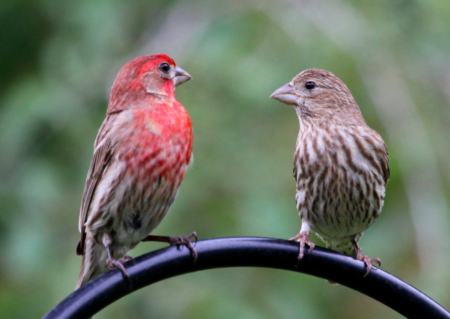
House finches (Haemorhous mexicanus) are originally from the Western United States. They arrived to the rest of the country via the pet trade in the 1940’s. And you can see why! These charming birds have a sweet song, and rosy red plumage on the males.
House finches are very comfortable around people. First, they trustingly build nests around human habitation. For example, I have had friends and neighbors leave Christmas wreaths out a little too long, only to find a finch nest on their front door! Secondly, house finches eat mostly seeds and some invertebrates when feeding their young, so they do great with birdfeeders.
Although they don’t move much in their native range, some house finches migrate in the East. In other words, if you’ve got them around in Spring, they could have been your neighbors all winter, or they could have just arrived. Available winter food and water from birdbaths and feeders makes them more likely to stick around.
2. Northern cardinal
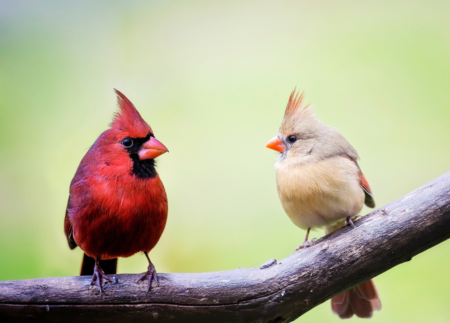
More often just known as the cardinal, this colorful, crested bird is hard to confuse. While the males sport familiarly scarlet plumage, the females have a mixture of softer yellows, light brown, salmon and orange hues. Meanwhile, both sexes sport a very bright, and very large red-orange bill.
Interestingly, Northern cardinals are actually Southern birds in the East. Until the middle of the 20th century, they weren’t often spotted in backyards in the Northeast. However, as suburban development spread northward, changing natural habitats, the cardinals spread too.
Like house finches, cardinals are big seed-eaters (look at that seed-cracking bill!). As a result, they also thrive around good birdfeeders. They prefer more shrubby and thick groundcover for nesting and hanging out.
Northern cardinals are generally non-migratory, or sedentary. They tend to inhabit roughly the same areas during the Winter as in the Spring. This can make them a familiar presence in your backyard.
3. Carolina wren & House wren
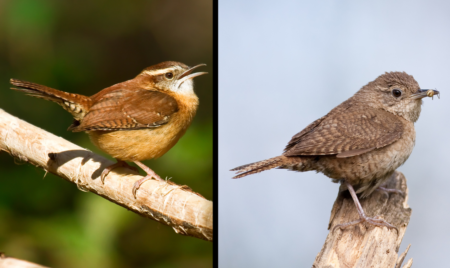
Wrens, in the family Troglodytidae, are generally spunky, brownish, bug-eating birds with gently down-curved bills. Homeowners in the Eastern US are likely to encounter two wren species in their backyards:
- the Carolina wren (Thryothorus ludovicianus)
- the House wren (Troglodytes aedon)
Among common backyard birds of the Eastern US, wrens have loud, pretty songs but skulkier behavior. They often hide among woodpiles, bushes, or lawn furniture, hunting for spiders or insects. Carolina wrens are larger and reddish in color, with orange-yellow bellies and a prominent white eyebrow-stripe. This distinctive field mark is also known as a supercilium. By contrast, house wrens are more uniformly brown with dark stripes, and are smaller in stature.
House wrens migrate South to warmer climes each winter, and their arrival and singing can be associated with spring. By contrast, Carolina wrens will typically stick around your yard right through the winter if you live in a colder climate.
4. Northern mockingbird
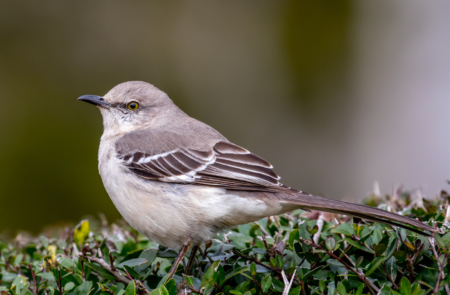
The Northern mockingbird is probably the most famous among backyard birds in the eastern US. In fact, they are so traditionally beloved that one in every ten US states has it as their state bird. Mockingbirds are relatively tall, slender, gray birds with long tails. They are very active, engaged, and quizzical, and aren’t much afraid of people.
This can be a problem, however. Specifically, when mockingbirds nest, they can be extremely defensive of their eggs and young. This means a lot of scolding, swooping, and even a peck on the head for any unsuspecting homeowner that strays too close.
Mockingbirds have an incredible ability to mimic birdsongs that they hear in their environment. They will even integrate car alarms and other catchy tunes into their repertoire!
If you want to get to know mockingbirds, check out acclaimed non-fiction author Phillip Hoose’s new book on Mockingbirds, Duet.
5. American crow
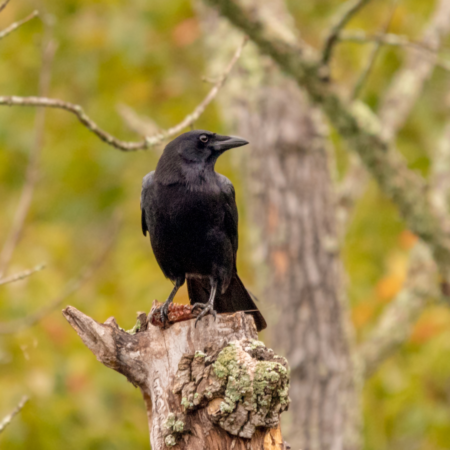
Crows are highly intelligent, large-bodied black birds belonging to the family Corvidae. They forage for carrion and take advantage of feeding opportunities like bird nests in the wild. Although they aren’t likely to visit your feeders, their affinity for developed landscapes and the food they can provide makes crows a frequent backyard bird. More often than not, they’re just passing through, and usually in groups.
American crows are highly social and build large stick nests, often in tall pine trees. Remarkably, research shows that they can identify and remember human faces. This means that any crow family in your neighborhood will remember any interactions that they’ve had with you!
6. American robin
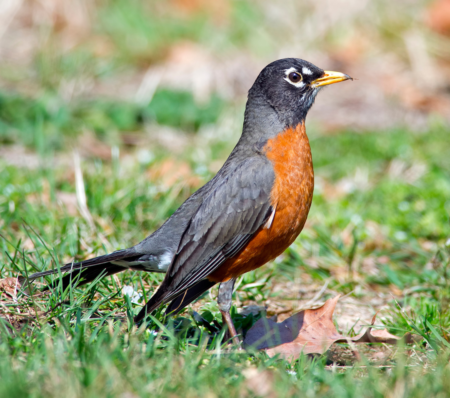
The American robin is one of the most widespread and familiar backyard birds in North America. Between their sweet song and bouncy, energetic behavior, robins tend to be a cheerful backyard presence. Although many people think of them as a sign of spring, they occur year-round in many areas.
These red-breasted, quick-flying birds love foraging for worms on lawns, especially after a rain. They belong to the thrush family, and often make mud-lined nests under eves and in backyard trees.
For a closer look a robins, check out their Wildlife Spotlight post on Gulo in Nature: Get to Know the American Robin!
7. European starling
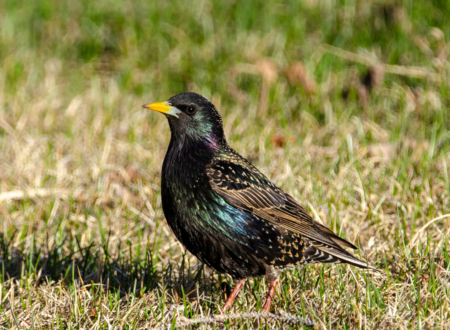
European starlings were introduced to North America in the late 1800’s. You can identify these talkative, social, dark-colored birds by their bright yellow bills during breeding season. Their beak is relatively long, and they have a short tail that gives them a football-like appearance in flight. During the Winter, they are dark with what appear to be white spots, and their beaks are black. In Summer, they take on a dark, glossy hue.
Starlings will typically show up in backyards in flocks, where they will probe the soil looking for grubs and worms. I imagine that this makes excellent pest control! Some people consider starlings invasive species, since they compete with some native birds for nesting sites.
8. Sharp-shinned or Cooper’s hawks
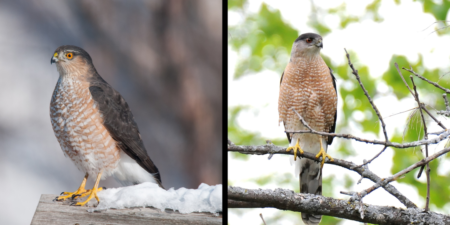
Sharp-shinned and cooper’s hawks are two species in a genus called Accipiter. You can tell these hawks from other species based on their small body size, flapping flight, and longer tails. They also tend to be very stripey, especially on the tail.
Unlike the larger soaring hawks (genus Buteo), accipiters feed on birds. If they turn up in your yard, chances are they’re looking to snatch an unsuspecting bird from your feeder.
Both of these species are relatively stealthy and you’ll more likely find them because other birds raise the alarm. I have often found them perched in dense cover with a good vantage point of nearby birdfeeders or bird baths.
9. Red-tailed hawk
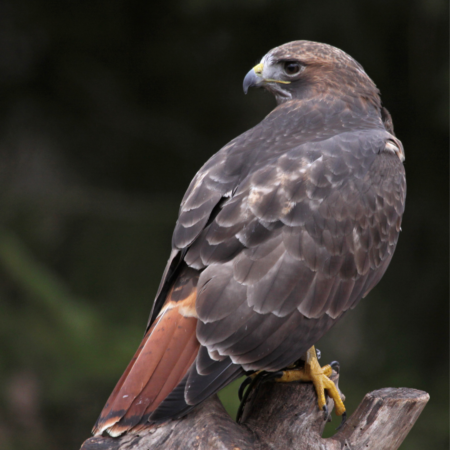
The red-tailed hawk is perhaps the most widespread hawk in the Americas. This sturdy hawk belongs to the Buteo genus, the soaring hawks. These tend to feed more on mammals like squirrels and voles than smaller-bodied hawks like the accipiters. While you won’t often find red-tailed hawks in your backyard, they may be soaring overhead. I typically only find them closer to the ground when they have jumped on an unlucky squirrel.
You can identify mature red-tailed hawks by their characteristically rusty-red tail. Many individuals also have a dark band of feathers across their chest. Their call is a long, high-pitched screech that you may recognize from movies and TV shows.
10. Blue jay
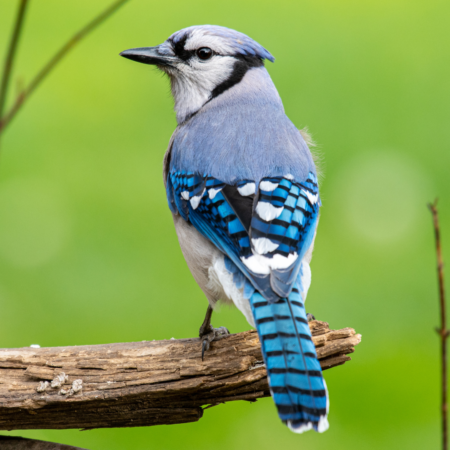
Blue jays are a smaller, less-gothic of crows and ravens in the family Corvidae. Their blue-and-white plumage and prominent crest, which they raise when excited, are key field marks for identification. Blue jays have a wide repertoire of loud, often raucous-sounding calls. They can even imitate backyard hawks to scare birds away from foods that they want!
These clever, active birds will take advantage of just about any food source a backyard has to offer. Blue jays are happy to visit feeders, although often they prefer other foods like invertebrates in your yard’s leaflitter. For a deep-dive into this cool backyard bird, check out this post on wild facts about Blue jays.
11. Common grackle

Grackles belong to the family Icteridae, also known as the New World Blackbirds. They typically have large tails and plumage that looks inky black. During the breeding season, they get gorgeous, colorful iridescence if the sun hits them right. Their yellowish-white eye against the dark backdrop of their feathers is also a dead giveaway.
Grackles hang out in large groups like starlings. Additionally, they can sometimes overlap with them in their love of wet yards and wetland areas. However, you can distinguish them based on body and tail size; grackles are larger with much larger tails. During the Spring and Summer, starlings will have yellow bills, and grackles, black. Meanwhile, in Fall and Winter, starlings have spots, while grackles remain a dull black.
These hefty birds will eat from feeders if they can, but often times they are too heavy. Even if they don’t stop in your backyard, they may be frequent flyovers. This is because they often roost at night in large numbers around wetland areas, and can be seen flying to and from these sights in the morning and evening.
12. American goldfinch
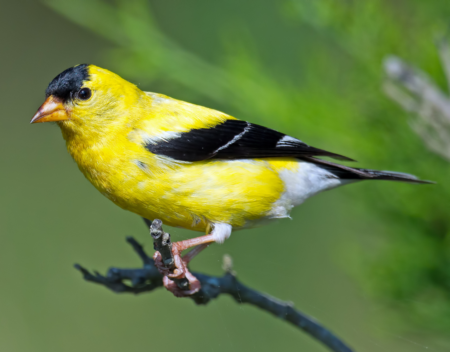
American goldfinches are one of my favorite backyard birds in the eastern US. They’re bright, colorful, make cheerful sounds, and are always reliable at a birdfeeder. They have a special love for thistle seeds and sunflowers, which are a sure way to bring them in. Goldfinches breed especially late in the year, in late Summer, making them an attractive backyard bird into the Fall.
Male goldfinches are a dramatic yellow with black wings and a black cap. Females have similar features, but a gentler greenish-yellow instead of the male’s highlighter-color. In winter, both sexes have a duller aspect to their plumage. Their chirpy flight call, which many think sounds like “potato chip! potato chip!” is a great way to identify them.
Want to learn more about backyard birds in the Eastern US?
Here are some great books for further reading on backyard birds.
Thanks for reading about common backyard birds in the Eastern US!
Do you have a favorite backyard bird in the Eastern US? Would you like to see another species on this list? Share with us in the comments! Also, be sure to follow Gulo in Nature on social media, and submit any other questions or requests to the Contact page.

